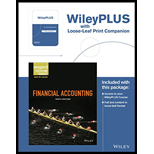
Concept explainers
(a)
Periodic Inventory System:
Periodic inventory system is a system in which the inventory is updated in the accounting records on a periodic basis such as at the end of each month, quarter or year. In other words, it is an accounting method which is used to determine the amount of inventory at the end of each accounting period.
First-in-First-Out:
In First-in-First-Out method, the costs of the initially purchased items are considered as cost of goods sold, for the items which are sold first. The value of the ending inventory consists of the recent purchased items.
Last-in-Last-Out:
In Last-in-First-Out method, the costs of last purchased items are considered as the cost of goods sold, for the items which are sold first. The value of the closing stock consists of the initial purchased items.
Moving -average cost method:
Under moving average cost method, the company calculates a new average cost after every purchase is made. It is determined by dividing the cost of goods available for sale by the units on hand. Following is the mathematical representation:
To Calculate: The ending inventory, cost of goods sold, gross profit, and gross profit rate under LIFO, FIFO, and Average-cost method.
(b)
To Compare: The results for the above three cost flow assumptions.
Want to see the full answer?
Check out a sample textbook solution
Chapter 6 Solutions
Financial Accounting, 10e WileyPLUS Registration Card + Loose-leaf Print Companion
- what is the annual interest rate? accounting questionarrow_forwardCan you solve this financial accounting question using valid financial methods?arrow_forwardWolfhard Construction Inc. purchased a used Caterpillar D8 bulldozer for $450,000 in February 2019. The company estimates the equipment's useful life to be 10 years and the salvage value to be $50,000. Using straight-line depreciation, calculate the depreciation expense for 2019, the first year of the equipment's life, and determine the equipment's net book value at December 31, 2021, after the third year of the equipment's life. [The company allows full-year depreciation regardless of purchase month] (Round your calculation to nearest number for Accumulated depreciation part if needed)arrow_forward

 AccountingAccountingISBN:9781337272094Author:WARREN, Carl S., Reeve, James M., Duchac, Jonathan E.Publisher:Cengage Learning,
AccountingAccountingISBN:9781337272094Author:WARREN, Carl S., Reeve, James M., Duchac, Jonathan E.Publisher:Cengage Learning, Accounting Information SystemsAccountingISBN:9781337619202Author:Hall, James A.Publisher:Cengage Learning,
Accounting Information SystemsAccountingISBN:9781337619202Author:Hall, James A.Publisher:Cengage Learning, Horngren's Cost Accounting: A Managerial Emphasis...AccountingISBN:9780134475585Author:Srikant M. Datar, Madhav V. RajanPublisher:PEARSON
Horngren's Cost Accounting: A Managerial Emphasis...AccountingISBN:9780134475585Author:Srikant M. Datar, Madhav V. RajanPublisher:PEARSON Intermediate AccountingAccountingISBN:9781259722660Author:J. David Spiceland, Mark W. Nelson, Wayne M ThomasPublisher:McGraw-Hill Education
Intermediate AccountingAccountingISBN:9781259722660Author:J. David Spiceland, Mark W. Nelson, Wayne M ThomasPublisher:McGraw-Hill Education Financial and Managerial AccountingAccountingISBN:9781259726705Author:John J Wild, Ken W. Shaw, Barbara Chiappetta Fundamental Accounting PrinciplesPublisher:McGraw-Hill Education
Financial and Managerial AccountingAccountingISBN:9781259726705Author:John J Wild, Ken W. Shaw, Barbara Chiappetta Fundamental Accounting PrinciplesPublisher:McGraw-Hill Education





